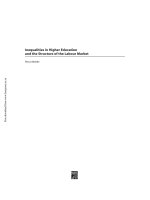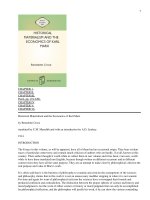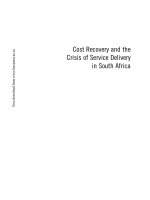After Saddam- Prewar Planning and the Occupation of Iraq pot
Bạn đang xem bản rút gọn của tài liệu. Xem và tải ngay bản đầy đủ của tài liệu tại đây (2.73 MB, 313 trang )
This document and trademark(s) contained herein are protected by law as indicated in a
notice appearing later in this work. This electronic representation of RAND intellectual
property is provided for non-commercial use only. Unauthorized posting of RAND PDFs
to a non-RAND Web site is prohibited. RAND PDFs are protected under copyright law.
Permission is required from RAND to reproduce, or reuse in another form, any of our research
documents for commercial use. For information on reprint and linking permissions, please
see RAND Permissions.
Limited Electronic Distribution Rights
Visit RAND at www.rand.org
Explore the RAND Arroyo Center
View document details
For More Information
Purchase this document
Browse Books & Publications
Make a charitable contribution
Support RAND
This PDF document was made available from www.rand.org as
a public service of the RAND Corporation.
6
Jump down to document
The RAND Corporation is a nonprofit research
organization providing objective analysis and
effective solutions that address the challenges facing
the public and private sectors around the world.
THE ARTS
CHILD POLICY
CIVIL JUSTICE
EDUCATION
ENERGY AND ENVIRONMENT
HEALTH AND HEALTH CARE
INTERNATIONAL AFFAIRS
NATIONAL SECURITY
POPULATION AND AGING
PUBLIC SAFETY
SCIENCE AND TECHNOLOGY
SUBSTANCE ABUSE
TERRORISM AND
HOMELAND SECURITY
TRANSPORTATION AND
INFRASTRUCTURE
WORKFORCE AND WORKPLACE
This product is part of the RAND Corporation monograph series. RAND
monographs present major research findings that address the challenges facing
the public and private sectors. All RAND monographs undergo rigorous peer
review to ensure high standards for research quality and objectivity.
ARROYO CENTER
After Saddam
Prewar Planning and the
Occupation of Iraq
Nora Bensahel, Olga Oliker, Keith Crane, Richard R. Brennan, Jr.,
Heather S. Gregg, Thomas Sullivan, Andrew Rathmell
Prepared for the United States Army
Approved for public release; distribution unlimited
The RAND Corporation is a nonprofit research organization providing
objective analysis and effective solutions that address the challenges facing
the public and private sectors around the world. RAND’s publications do
not necessarily reflect the opinions of its research clients and sponsors.
R
®
is a registered trademark.
© Copyright 2008 RAND Corporation
All rights reserved. No part of this book may be reproduced in any
form by any electronic or mechanical means (including photocopying,
recording, or information storage and retrieval) without permission in
writing from RAND.
Published 2008 by the RAND Corporation
1776 Main Street, P.O. Box 2138, Santa Monica, CA 90407-2138
1200 South Hayes Street, Arlington, VA 22202-5050
4570 Fifth Avenue, Suite 600, Pittsburgh, PA 15213-2665
RAND URL:
To order RAND documents or to obtain additional information, contact
Distribution Services: Telephone: (310) 451-7002;
Fax: (310) 451-6915; Email:
The research described in this report was sponsored by the United States
Army under Contract No. DASW01-01-C-0003.
Library of Congress Cataloging-in-Publication Data
After Saddam : prewar planning and the occupation of Iraq / Nora Bensahel [et al.].
p. cm.
Includes bibliographical references.
ISBN 978-0-8330-4458-7 (pbk. : alk. paper)
1. Iraq War, 2003– 2. Military planning—United States. 3. Postwar
reconstruction—Iraq. 4. Coalition Provisional Authority. 5. Insurgency—Iraq.
6. National security—Iraq. I. Bensahel, Nora, 1971–
DS79.76A345 2008
956.7044'3—dc22
2008025846
iii
Preface
Soon after Operation IRAQI FREEDOM (OIF) began in March 2003, RAND Ar-
royo Center began a research project at the request of the U.S. Army. This project set
out to prepare an authoritative account of the planning and execution of combat and
stability operations in Iraq and to identify key issues that could affect Army plans and
goals, operational concepts, doctrine, and other Title 10 responsibilities.
The resulting body of work will interest those involved in organizing, training,
and equipping military forces to plan for, deploy to, participate in, and support joint
and coalition operations. Although focused primarily on Army forces and activities,
the analysis also describes other aspects of joint and combined operations. RAND
analysts collected the information in these volumes from many sources, including
unit after-action reports, compilations of lessons learned, official databases, media
reports, other contemporary records, and interviews with key participants in OIF.
The results of this project are documented in multiple volumes, some not avail-
able to the general public, as described below:
• Decisive War, Elusive Peace: Operation IRAQI FREEDOM, MG-641-A, Richard
E. Darilek, Walter L. Perry, Laurinda L. Rohn, and Jerry M. Sollinger, editors.
This volume is an overview of the research findings.
• After Saddam: Prewar Planning and the Occupation of Iraq, MG-642-A, Nora
Bensahel, Olga Oliker, Keith Crane, Richard R. Brennan, Jr., Heather S.
Gregg, Thomas Sullivan, and Andrew Rathmell. This volume is a treatment of
the prewar planning for the postwar situation and of postwar military and re-
construction activities.
• Operation IRAQI FREEDOM: Executive Summary, MG-643-A, Walter L. Perry,
Laurinda L. Rohn, and Jerry M. Sollinger. This volume, not available to the
general public, presents an executive summary of the research findings.
• Operation IRAQI FREEDOM: Volume I, The Genesis, MG-643/1-A, Jefferson P.
Marquis, Walter L. Perry, David E. Mosher, Stephen T. Hosmer, Andrea
Mejia, Richard E. Darilek, Jerry M. Sollinger, Vipin Narang, Charles W. Yost,
John Halliday, and John R. Bondanella. This volume, not available to the gen-
iv After Saddam: Prewar Planning and the Occupation of Iraq
eral public, describes the political and military activities leading up to the opera-
tion.
• Operation IRAQI FREEDOM: Volume II, Defeating Saddam, MG-643/2-A,
Bruce R. Pirnie, John Gordon IV, Richard R. Brennan, Jr., Forrest E. Morgan,
Alexander C. Hou, and Charles W. Yost. This volume, not available to the gen-
eral public, covers major combat operations in Iraq.
• Operation IRAQI FREEDOM: Volume III, Managing the War, MG-643/3-A,
Walter L. Perry, Edward O’Connell, Miranda Priebe, Forrest E. Morgan,
Lowell H. Schwartz, and Alexander C. Hou. This volume, not available to the
general public, describes the command and control (C2) of the forces and sup-
porting operations.
• Operation IRAQI FREEDOM: Volume IV, Prewar Planning and the Occupation
of Iraq, MG-643/4-A, Nora Bensahel, Olga Oliker, Keith Crane, Richard R.
Brennan, Jr., Heather S. Gregg, Thomas Sullivan, and Andrew Rathmell. This
volume, not available to the general public, describes the prewar planning for
the postwar situation and postwar military and reconstruction activities.
• Operation IRAQI FREEDOM: Volume V, Sustaining the Force, MG-643/5-A,
Eric Peltz, David Kassing, Jerry M. Sollinger, Marc Robbins, Kenneth J. Girar-
dini, Peter Schirmer, Robert Howe, and Brian Nichiporuk. This volume, not
available to the general public, covers the mobilization and sustainment of the
forces.
This report provides an unclassified treatment of the post–major combat mili-
tary and stabilization activities. It begins by examining prewar planning for postwar
Iraq, in order to establish what U.S. policymakers expected the postwar situation to
look like and what their plans were for stabilization. The report then examines the
role of U.S. military forces after major combat officially ended on May 1, 2003. Fi-
nally, the report examines civilian efforts at reconstruction, focusing on the activities
of the Coalition Provisional Authority (CPA) and its efforts to rebuild structures of
governance, security forces, economic policy, and essential services prior to June 28,
2004, the day that CPA dissolved and transferred authority to the Iraqi Interim Gov-
ernment. The research for this volume was completed in September 2004 and the
final draft was submitted in October 2004.
The purpose of this analysis is to find out where problems occurred and to sug-
gest possibilities to improve planning and operations in the future. The results of
such analysis can seem therefore to be overly focused on the negative. This should
not be taken to mean that no good was done. In fact, dedicated U.S. and coalition
personnel, both military and civilian, engaged in many positive and constructive ac-
tivities, individually and collectively. That this analysis does not highlight all those
activities should not in any way detract from their value. Our focus, however, re-
mains on finding ways to improve.
Preface v
This research was co-sponsored by the Deputy Chief of Staff, G-3, U.S. Army,
and the Deputy Chief of Staff, G-8, U.S. Army. It was conducted in RAND Arroyo
Center’s Strategy, Doctrine, and Resources Program. RAND Arroyo Center, part of
the RAND Corporation, is a federally funded research and development center spon-
sored by the United States Army.
The Project Unique Identification Code (PUIC) for the project that produced
this document is DAMOAX003.
For more information on RAND Arroyo Center, contact the Director of Op-
erations (telephone 310-393-0411, extension 6419; FAX 310-451-6952; email
), or visit Arroyo’s web site at
vii
Contents
Preface iii
Figures xiii
Tables xv
Summary xvii
Acknowledgments xxxi
List of Acronyms and Abbreviations xxxiii
CHAPTER ONE
Introduction 1
CHAPTER TWO
Military Planning Efforts 5
CENTCOM Operational Planning 6
Combined Forces Land Component Command (CFLCC) Phase IV Planning 10
Planning at V Corps and Subordinate Commands 14
Observations 14
CHAPTER THREE
Civilian Planning Efforts 21
Interagency Planning: The ESG and the IPMC 21
The Office of the Secretary of Defense 24
The Office of Special Plans 24
Policy Guidance 26
OSD’s Role in Policymaking 28
State Department Planning 29
The State Department and Interagency Planning 30
The Future of Iraq Project 31
USAID Planning 33
Reconstruction Planning and Contracting 33
Coordination with Other Agencies 34
viii After Saddam: Prewar Planning and the Occupation of Iraq
The National Security Council 35
De-Ba’athification 36
Restructuring Iraqi Military and Security Institutions 36
Other Analyses of Postwar Requirements 37
CHAPTER FOUR
Task Force IV 41
Establishing Task Force IV 41
Task Force IV Planning 42
Operational Challenges 46
Staffing Issues 46
Relations with CENTCOM and CFLCC 47
Relations with ORHA 50
The Dissolution of Task Force IV 51
CHAPTER FIVE
The Office of Reconstruction and Humanitarian Assistance 53
Organization and Staffing 53
ORHA Planning 58
The February Rock Drill 59
ORHA’s Role in Reconstruction 64
Deploying to Kuwait 65
Arriving in Baghdad 68
The Transition to CPA 70
CHAPTER SIX
Humanitarian Planning 73
Interagency Humanitarian Planning 73
IO and NGO Frustrations 77
Actual Humanitarian Requirements 78
Assessing Humanitarian Planning 79
CHAPTER SEVEN
Combat Operations During Phase IV 81
Phase IVa: Stability Operations 81
Anticipated Security Challenges 81
Security Challenges During the Transition to Phase IVa 82
Initial Response to Civil Unrest 84
Stabilization Efforts, March to June 2003 86
Phase IVb: Recovery Operations 93
Organization for Phase IVb 93
The Growing Insurgency 94
Contents ix
CHAPTER EIGHT
The Coalition Provisional Authority 101
The Origins and Authorities of CPA 101
Goals 104
Other Governing Institutions 106
Iraqi Governing Council (IGC) 106
Ministries 107
Organization of CPA 109
Location and Staffing 115
Relations with CJTF-7 118
Concluding Observations 120
CHAPTER NINE
Building New Iraqi Security Forces 121
Defining and Building Iraqi Security Forces 121
Building the MoI 123
Creating the Iraqi Police Service (IPS) 124
The Facilities Protection Services 132
The Border Police 135
High-End MoI Forces 137
Ministry of Defense 138
The Iraqi Armed Forces 139
Dissolution of the Iraqi Armed Forces: Aftermath 139
Designing a New Force 141
Building the New Force 143
Changing Goals and Parameters 145
Success or Failure? 146
Iraqi Civil Defense Corps (ICDC) 147
Intelligence 150
National Security Decisionmaking Structures 151
Iraqi Armed Forces and the Handover of Power 153
Integrating the Armed Forces and Militias Not Under Government Control 154
Concluding Observations 156
CHAPTER TEN
Governance and Political Reconstruction 159
Prewar Planning for Postwar Governance 159
Postwar Governance: The Iraqi Governing Council 160
The November 15 Agreement and the Transfer of Authority 171
The Transitional Administrative Law 179
Provincial and City Governance 182
x After Saddam: Prewar Planning and the Occupation of Iraq
Lessons Learned 187
Security and Political Development 187
The Role of Exiles in the New Government 188
Bringing All Groups into the Political Process 189
Flexibility in Creating a New Government and Establishing Reasonable Timelines 190
Publicizing Political Developments and Informing the Population 191
The Importance of Civil Society and Political Culture 192
CHAPTER ELEVEN
Economic Policy 195
Economic Conditions in Iraq at the End of Major Combat 195
Economic Policies Pursued by CPA 197
Restarting the Economy 197
Resuming the Provision of Government Services 198
Controlling Inflation 199
Tariffs and Taxes 201
The Budget 202
Law on Foreign Direct Investment 202
Economic Policy Changes That Were Not Fully Implemented 203
Price Liberalization 203
Reforming the Food Rationing System 204
Rationalizing State-Owned Enterprises 206
Lessons Learned 208
CHAPTER TWELVE
Essential Services and Infrastructure 211
Status at the End of Major Combat 211
Prewar Assumptions 212
Contracting for the Resumption of Essential Services 215
Initial Contracts 216
Post-Conflict Contracts in FY2003 217
The Project Management Office 218
The Players: Who Was Involved in Reconstruction 219
Iraqi Ministries and State-Owned Enterprises 219
CPA 219
Regional Military Commanders 220
U.S. Government Contracting Institutions 220
International Institutions 220
Contractors 220
Financing 221
Coordinating and Implementing Reconstruction Projects 224
Contents xi
Project Selection 224
Reconstruction and Project Management 225
Allocation of Funds 228
Results as of June 28, 2004 229
Resuming the Provision of Essential Services 229
Expenditures 230
Costs 230
Quality Control 231
CHAPTER THIRTEEN
Assessing Postwar Efforts 233
Shaping the Plan 233
Unchallenged Assumptions and Expectations 234
Ineffective Interagency Coordination 237
Security as the Key Postwar Task 239
Lessons for the Army 241
APPENDIX
Strategic Studies Institute’s Mission Matrix for Iraq 245
Bibliography 255
xiii
Figures
2.1. Military Presence at Outset of Post-Conflict Operations 17
3.1. OUSD(P) and NESA Organization Chart 25
4.1. Planned Sectors for CJTF-Iraq 44
4.2. Proposed Force Structure for CJTF-Iraq 45
5.1. Initial ORHA Organization Chart 55
5.2. Revised ORHA Organization Chart 57
7.1. Phase IVa Occupation of Iraq 87
7.2. CJTF-7 Task Organization, June 2003 94
7.3. CJTF-7 Areas of Operations, June 2003 95
8.1. Original Organization of CPA, July 2003 110
8.2. Revised Organization as of November 2003 114
8.3. Location of the Palace in Baghdad 115
xv
Tables
5.1. Planned Ministerial Advisory Teams, February 2003 60
9.1. Iraqi Police Service Training 128
9.2. Facilities Protection Services 134
9.3. Department of Border Enforcement 136
9.4. New Iraqi Security Forces 158
10.1. The Iraqi Governing Council, July 2003 167
10.2. Cabinet Appointments, September 2003 170
10.3. Iraqi Interim Government, June 2004 177
12.1. Major Reconstruction Contracts for Iraq as of September 30, 2003 221
12.2. Total Funds Available, Obligated, and Disbursed for Iraq by Source
as of April 2004 (in billions of U.S. dollars)
222
A.1. Mission Matrix for Iraq 246
xvii
Summary
Major combat operations in Iraq lasted approximately three weeks, but stabilization
efforts in that country are, as of this writing, ongoing. The U.S. Army and the U.S.
Marine Corps are increasingly taxed by the demands of the continuing insurgency,
with more than 100,000 troops expected to remain in Iraq for the foreseeable future.
The evidence suggests that the United States had neither the people nor the
plans in place to handle the situation that arose after the fall of Saddam Hussein.
Looters took to the streets, damaging much of Iraq’s infrastructure that had remained
intact throughout major combat. Iraqi police and military units were nowhere to be
found, having largely dispersed during combat. U.S. military forces in Baghdad and
elsewhere in the country were not prepared to respond rapidly to the initial looting
and subsequent large-scale public unrest. These conditions enabled the insurgency to
take root, and the Army and Marine Corps have been battling the insurgents ever
since.
Why was the United States so unprepared for the challenges of postwar Iraq? As
part of a larger study of Operation IRAQI FREEDOM (OIF), RAND Arroyo Cen-
ter examined prewar planning for postwar Iraq and the subsequent occupation to
seek an answer to this question and to draw lessons and recommendations from the
Iraq experience.
It is not the case that no one planned for post-Saddam Iraq. On the contrary,
many agencies and organizations within the U.S. government identified a range of
possible postwar challenges in 2002 and early 2003, before major combat com-
menced, and suggested strategies for addressing them. Some of these ideas seem quite
prescient in retrospect. Yet few if any made it into the serious planning process for
OIF.
They were held at bay, in the most general sense, by two mutually reinforcing
sets of assumptions that dominated planning for OIF at the highest levels. Although
many agencies and individuals sought to plan for post-Saddam Iraq, senior policy-
makers throughout the government held to a set of fairly optimistic assumptions
about the conditions that would emerge after major combat and what would be re-
quired thereafter. These assumptions tended to override counterarguments elsewhere
xviii After Saddam: Prewar Planning and the Occupation of Iraq
in the government. Meanwhile, senior military commanders assumed that civilian
authorities would be responsible for the postwar period. Hence they focused the vast
majority of their attention on preparations for and the execution of major combat
operations. That both sets of assumptions proved to be invalid argues for the devel-
opment of a new and broader approach to planning military operations, and perhaps
a louder military voice in shaping postwar operations.
Military Planning for Phase IV
The notion of a “Phase IV” in OIF came out of the war planning process that com-
menced in the fall of 2001, shortly before the fall of the Taliban in Afghanistan. On
November 27, 2001, the Secretary of Defense directed U.S. Central Command
(CENTCOM) to develop a plan to remove Saddam Hussein from power. The plan
that emerged for OIF, later called OPLAN 1003V, outlined four phases: establishing
international support and preparing for deployment; shaping the battlespace; major
combat operations; and post-combat operations. The final version of OPLAN 1003V
provided guidance and responsibilities for Phase IV operations, giving CENTCOM’s
land component, the Combined Forces Land Component Command (CFLCC),
primary responsibility for post-combat operations.
Both CENTCOM and CFLCC developed supporting OPLANs in early 2003
that focused on Phase IV operations. Elements of each of these plans appear fairly
prescient in retrospect. Yet they were always a low priority at CENTCOM, which
focused the vast bulk of its time, attention, and resources on major combat opera-
tions. Although CENTCOM’s commander, General Tommy Franks, refers to Phase
IV frequently in his memoirs, for example, he never identifies the specific mission
that U.S. forces should have had during that time. To the contrary: He expresses the
strong sentiment that his civilian superiors should focus on postwar operations while
he focused on the war itself.
1
He goes on to argue that civic action sets the precondi-
tions for security rather than the other way around.
2
And he justifies his decision to
retire right after combat ended because the mission was changing and a new com-
mander should be there throughout Phase IV.
3
____________
1
Franks states, “While we at CENTCOM were executing the war plan, Washington should focus on policy-level
issues . . . I knew the President and Don Rumsfeld would back me up, so I felt free to pass the message along to
the bureaucracy beneath them: You pay attention to the day after and I’ll pay attention to the day of.” Tommy
Franks, American Solider, New York: Regan Books, 2004, p. 441. Emphasis in the original.
2
Franks writes, “As I had said throughout our planning sessions, civic action and security were linked—
inextricably linked. There was a commonly held belief that civil action would not be possible in Iraq without
security. I would continue to argue that there could be no security without civic action.” Franks, p. 526. Empha-
sis in the original.
3
Franks, p. 530.
Summary xix
In short, General Franks saw major combat operations during Phase III as fun-
damentally distinct from Phase IV stability and reconstruction requirements, and as
the military’s primary task. That mindset reinforced an understandable tendency at
CENTCOM to focus planning on major combat as an end in itself rather than as a
component part of a broader effort to create a stable, reasonably democratic Iraq.
The result, arguably, was a military operation that made the latter, larger goal more
difficult to achieve.
Civilian Planning for Phase IV
General Franks was correct in seeing the need for greater civilian involvement in the
stabilization of Iraq, since civilian agencies possess many of the capabilities needed
for post-conflict operations. In fact, several U.S. government organizations, particu-
larly the Office of the Secretary of Defense (OSD), the State Department, the U.S.
Agency for International Development (USAID), and the National Security Council
(NSC) conducted separate studies of postwar possibilities. The problem, therefore,
was not that no one in the U.S. government thought about the challenges of post-
Saddam Iraq. Rather, it was the failure to coordinate and integrate these various
thoughts into a coherent, actionable plan.
At the center of the interagency planning process lay the NSC, which, starting
in the summer of 2002, oversaw several interagency working groups that brought
together representatives from the Department of Defense (DoD), the Department of
State, the Central Intelligence Agency (CIA), and other organizations. Most of these
working groups focused on the conduct of the war, but the working group on Iraq
Relief and Reconstruction (IR+R) focused on postwar plans. This group produced
fairly detailed humanitarian relief plans, but its reconstruction plans remained vague,
reflecting a sense that reconstruction would not be necessary and stabilization would
be handled by the Iraqis themselves.
If the NSC staff failed to consider alternative scenarios that might pose differing
requirements, neither did it provide strategic guidance on various aspects of U.S. pol-
icy during the postwar period. Repeated requests for policy guidance from
CENTCOM, Task Force IV, the Office of Reconstruction and Humanitarian Assis-
tance (ORHA), and others went unanswered, leaving each agency to make its own
assumptions about key aspects of the postwar period. Key questions, such as whether
the U.S. postwar authority would be military or civilian in nature, went unanswered
throughout the planning process. When the NSC issued strategic guidance in late
March 2003 (as will be discussed in Chapter Three), the war was already under way.
As a result, the various planning processes that occurred across the U.S. government
were neither coordinated nor guided by a set of consistent goals and objectives.
xx After Saddam: Prewar Planning and the Occupation of Iraq
Above all, the NSC seems not to have mediated persistent disagreement be-
tween the Defense Department and the State Department that existed throughout
the planning process. Secretary of State Colin Powell influenced a few key diplomatic
decisions—notably the decision to take the case for war with Iraq to the United Na-
tions in September 2002—but the Defense Department controlled most planning
decisions. State’s main postwar planning effort, the Future of Iraq project, may not
have been a workable plan for post-Saddam Iraq, but it raised many of the right
questions about that phase of OIF. Yet the Defense Department largely ignored this
project, to the point of preventing Tom Warrick, the study’s leader, from working
for ORHA in the weeks just before the war began.
The Defense Department created a new office to handle the increased workload
associated with potential military operations in Iraq. It was called the Office of Spe-
cial Plans (OSP), so as not to draw attention to the preparations for a possible war
while President Bush simultaneously sought international support at the United Na-
tions. OSP developed policy guidance on a wide range of issues, including the ques-
tion of postwar governance, the future of the Iraqi army, and the de-Ba’athification
process. Because the DoD exercised a great deal of control over planning for OIF,
and ultimately took full control of the operation in January 2003, OSP exerted sub-
stantial influence over U.S. planning for Iraq.
Two particular sets of assumptions guided U.S. prewar planning for the postwar
period. First, administration officials assumed that the military campaign would have
a decisive end, and would produce a stable security situation. They intended to
shrink the U.S. military presence down to two divisions—between 30,000 and
40,000 troops—by the fall of 2003. Deputy Secretary of Defense Paul Wolfowitz
succinctly expressed this assumption during congressional testimony on February 27,
2003, when he stated, “It’s hard to conceive that it would take more forces to provide
stability in post-Saddam Iraq than it would take to conduct the war itself and to se-
cure the surrender of Saddam’s security forces and his army.”
4
Second, they assumed
that the Iraqi population would welcome U.S. forces. Three days before the war,
Vice President Richard Cheney clearly articulated this view by stating, “My belief is
we will, in fact, be greeted as liberators.”
5
Iraqi exiles supported this belief by empha-
sizing that the Iraqis would greet U.S. forces with “sweets and flowers.”
6
The one post-Saddam challenge for which the U.S. government actually
planned was that of a possible humanitarian emergency brought on by the possibly
massive flow of refugees, combined with shortages of food, water, and medicine. An
interagency planning team started meeting in the fall of 2002 and worked with in-
____________
4
Paul Wolfowitz, testimony to the House Budget Committee, February 27, 2003.
5
Vice President Richard Cheney, remarks to Meet the Press, March 16, 2003.
6
Kanan Makiya, as quoted in Joel Brinkley and Eric Schmitt, “Iraqi Leaders Say U.S. Was Warned of Disorder
After Hussein, but Little Was Done,” New York Times, November 30, 2003.
Summary xxi
ternational organizations (IOs) and nongovernmental organizations (NGOs) to gen-
erate detailed humanitarian relief plans across a range of possible scenarios. As it
turned out, because of the speed of military operations, which left supply networks
largely intact, the war in Iraq did not generate significant humanitarian require-
ments.
Task Force IV
Significantly, observers at CENTCOM’s Internal Look exercise, held in December
2002, noted that the warplans for Iraq did not include detailed planning for the
postwar period. Later that month, the Chairman of the Joint Chiefs of Staff ordered
Joint Forces Command to create a new organization, based on the Standing Joint
Force Headquarters (SJFHQ) concept, that would plan for Phase IV and form the
nucleus of a postwar military headquarters in Iraq. This new organization, called
Task Force IV (TFIV), was placed under CENTCOM’s operational control and
started assembling in Tampa in January 2003.
Although the Joint Staff had identified an extremely important problem with
the existing warplans, Task Force IV proved to be an unworkable solution to it. Hav-
ing been created very late in the planning process, and coming from outside
CENTCOM, it had little influence. The fact that the task force’s director was a one-
star general, outranked by key players in CENTCOM’s planning process, only com-
pounded the problem. By March 2003, it was clear that Task Force IV would not
become the nucleus of a postwar military headquarters, and it was officially dis-
banded by the end of the month.
The Office of Reconstruction and Humanitarian Assistance (ORHA)
On January 20, 2003, the National Security Council issued NSPD-24, which gave
the Department of Defense primary responsibility for postwar Iraq and tasked DoD
to form a new office to take charge of planning. Retired Army Lieutenant General
Jay Garner was named to lead this new office, which became known as ORHA.
Many of ORHA’s early staff members were military personnel because U.S. agencies
proved reluctant to provide staff for ORHA, though its composition grew more bal-
anced over time.
ORHA personnel soon discovered that the many administrative issues involved
in setting up their organization left little time to deal with substantive issues and
long-term planning. ORHA did plan for possible humanitarian relief operations,
drawing on interagency relief plans prepared elsewhere. It also developed the concept
of Ministerial Advisory Teams to ensure that Iraqi ministries continued to function
xxii After Saddam: Prewar Planning and the Occupation of Iraq
between the fall of Saddam Hussein and the establishment of a new permanent gov-
ernment. These concepts were discussed at a meeting held at the National Defense
University on February 21 and 22, 2003, which included representatives from every
U.S. government agency that would have a role in reconstruction. The meeting re-
vealed several serious shortcomings in preparations for dealing with postwar Iraq:
U.S. agencies were reluctant to provide personnel for the ministerial teams, and the
question of who would provide postwar security in Iraq remained unaddressed. Both
of these issues would later pose significant problems for both ORHA and its succes-
sor, the Coalition Provisional Authority (CPA).
ORHA deployed to Kuwait in mid-March 2003, although many staff members
would have preferred to remain in Washington longer to continue developing work-
ing relationships with their counterparts throughout the U.S. government. Once in
Kuwait, ORHA learned that, for security reasons, the CFLCC commander did not
want ORHA collocated with his forces at Camp Doha. ORHA thus set up its head-
quarters at the Kuwait Hilton, approximately 45 minutes away from Camp Doha
and lacking rudimentary communications and infrastructure.
Significantly, ORHA’s personnel were not privy to the warplans until shortly
before the war started. ORHA had planned to enter Basra and start reconstruction
efforts as soon as coalition military forces secured that city, but during the second
week of March, Garner learned that the warplans called for most military forces to go
straight to Baghdad instead of remaining in rear areas to provide security, thus ren-
dering many of ORHA’s plans obsolete. CFLCC directed ORHA to remain in Ku-
wait while major combat operations were conducted throughout Iraq. Not only did
this render its plans ineffective, but once Baghdad fell and the looting started, it ex-
posed ORHA to charges that it was doing nothing to stop destruction around the
country.
ORHA began entering Baghdad on April 21, after Garner personally asked for
and received permission to do so from General Franks. ORHA quickly discovered
that conditions in Iraq were markedly different from those originally anticipated.
The expected humanitarian crisis never materialized, while extensive looting dam-
aged much of the infrastructure that the military campaign had deliberately left in-
tact. Furthermore, the unsettled security situation significantly hindered ORHA’s
reconstruction efforts.
ORHA’s planning problems quickly became irrelevant, however, as on April 24,
three days after Garner arrived in Baghdad, the Secretary of Defense informed him
that President Bush intended to appoint L. Paul Bremer as his permanent envoy to
Iraq. U.S. officials announced Bremer’s appointment on May 6, and he arrived in
Baghdad on May 12 with a mandate to create a new Coalition Provisional Authority.
Unlike ORHA, CPA would possess all the powers of an occupation authority.
ORHA’s staff shrank as CPA’s grew, with few ORHA personnel choosing to stay on
Summary xxiii
and work for CPA. Garner left Iraq on June 1, almost two weeks after ORHA had
been superseded by CPA.
The Coalition Provisional Authority
In May 2003, the Coalition Provisional Authority took over from ORHA, and
L. Paul Bremer became the administrator of Iraq. From then until Bremer handed
power over to the Iraqis on June 28, 2004, the United States and the United King-
dom were the legal occupiers of Iraq. They had two simultaneous and sometimes
competing missions: to run the country and to build up Iraqi institutions that would
enable self-rule. The November 2003 decision to accelerate the handover of power
by July 1, 2004, exacerbated the tension between the two missions.
Although CPA was the governing body of occupied Iraq, it was not the only
coalition structure in country, and it did not have authority over all other structures.
Combined Joint Task Force 7 (CJTF-7), the military command, which reported to
CENTCOM, functioned separately, as did various intelligence agencies (including
the CIA), and the Iraq Survey Group, which continued its hunt for weapons of mass
destruction (WMD). In the absence of a detailed plan, these groups had to work out
relations on the spot. While personal relations were often good, failures of coordina-
tion and information sharing sometimes created significant tensions, most commonly
between the civilian and the military arms of the occupation.
This problem was further exacerbated by the structural weaknesses of the CPA.
It remained limited throughout its existence by the fact that the United States had
never planned to be an occupying authority, and that it was quickly assembled on an
ad hoc basis. It was staffed at half its authorized level, and many on its staff lacked
government experience and only served short rotations. The lack of personnel, com-
bined with the deteriorating security situation, also meant that CPA had a negligible
presence outside Baghdad, leaving military forces throughout the rest of the country
to fill the gap left by the lack of civilian authority and reconstruction capacity. The
Army and Marine Corps thus carried the major share of the stability and reconstruc-
tion missions outside Baghdad.
Building governance structures. CPA worked hard to build governance struc-
tures under the tremendous strain of a deteriorating security situation that did not
welcome exiles. At the same time, the CPA staff’s lack of access to other Iraqis re-
sulted in continued reliance on exiles in the building of a new Iraq. The CPA ap-
pointed the Iraqi Governing Council (IGC)—a multi-ethnic, multi-sectarian, and
exile/Kurdish-dominated body—on July 13, 2003, after considerable debate and dis-
cussion about what form the new Iraqi government should take. While it was never
popular with Iraqis, this 25-person body became over time an increasingly independ-
ent actor and CPA’s primary Iraqi interlocutor.









